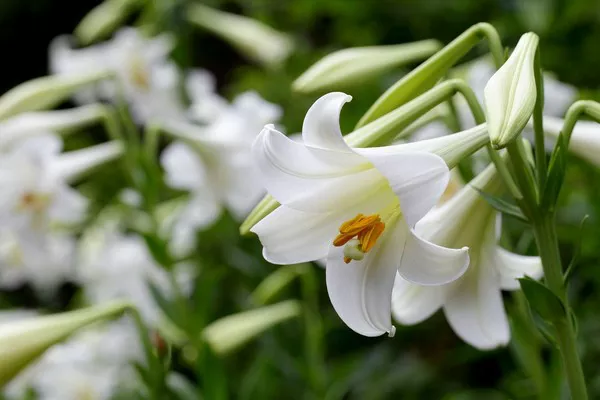Lilies are beloved for their vibrant colors, elegant shapes, and enchanting fragrance. Whether adorning a garden, bouquet, or floral arrangement, these majestic blooms bring a touch of grace and sophistication to any setting. While fresh lilies captivate with their ephemeral beauty, drying them allows their splendor to be enjoyed long after their prime. In this guide, we explore the art of drying lily flowers, covering selection, methods of drying, and post-drying preservation techniques to ensure their lasting allure.
Selecting the Perfect Lilies for Drying
Successful drying begins with selecting the right lilies. Here are some key considerations:
1. Choose Fresh, Healthy Blooms: Opt for lilies that are fully developed but not yet fully opened. Look for flowers with vibrant colors and unblemished petals.
2. Select Varieties Suitable for Drying: While many lily varieties can be dried, some are better suited for this purpose than others. Oriental and Asiatic lilies, with their sturdy petals and rich colors, are popular choices for drying.
3. Harvest at the Right Time: Time your harvest for when the flowers are at their peak. For most lilies, this means cutting them when the buds have just started to open, but before they are fully matured.
4. Consider the Stem Length: Longer stems provide more flexibility for arranging and handling during the drying process. Aim for stems that are at least 6 to 8 inches long.
By carefully selecting lilies with these characteristics, you set the stage for successful drying and preservation.
Methods of Drying Lilies
Once you’ve chosen the perfect lilies, it’s time to dry them. Several methods can be employed, each offering its own benefits and considerations:
1. Air Drying:
Air drying is one of the simplest and most accessible methods for drying lilies. Here’s how to do it:
- Gather the lilies into small bunches, securing the stems with rubber bands or twine.
- Hang the bunches upside down in a warm, dry, and well-ventilated area, away from direct sunlight.
- Allow the lilies to air dry for approximately two to three weeks, or until the petals feel papery to the touch.
2. Silica Gel Drying:
Silica gel is a desiccant that absorbs moisture, making it an effective method for drying flowers while preserving their shape and color. Follow these steps for silica gel drying:
- Pour a layer of silica gel into a container deep enough to accommodate the lilies without bending or folding the petals.
- Trim the stems of the lilies to the desired length and gently place them upright in the silica gel.
- Carefully pour additional silica gel over the lilies until they are completely covered.
- Seal the container and leave it undisturbed for about one to two weeks, or until the lilies are thoroughly dried.
3. Pressing:
Pressing is ideal for preserving lilies as flat specimens for use in crafts or decor. Here’s how to press lilies:
- Place the lilies between layers of absorbent paper, such as blotting paper or newspaper.
- Arrange the flowers carefully to preserve their shape, spacing them apart to avoid overlapping.
- Add weight on top of the stack, such as heavy books or bricks, to press the flowers flat.
- Leave the flowers pressed for several weeks, replacing the absorbent paper as needed until the flowers are fully dried.
- Each drying method offers unique advantages, allowing you to choose the approach that best suits your preferences and resources.
Post-Drying Preservation Techniques
After drying your lilies, it’s essential to preserve them properly to maintain their beauty and longevity. Consider the following techniques:
1. Applying a Preservative Spray:
- Once the lilies are completely dried, you can apply a preservative spray to help protect them from moisture and prolong their lifespan.
- Commercial floral preservative sprays are available, or you can make your own by mixing equal parts of glycerin and water.
2. Sealing with Wax:
- For added protection and a glossy finish, you can seal dried lilies with melted wax. Dip the flowers gently into melted paraffin wax, allowing excess wax to drip off before setting them aside to dry.
3. Displaying in airtight Containers:
- To prevent exposure to humidity and dust, consider displaying your dried lilies in airtight containers, such as glass jars or display cases. Add silica gel packets to absorb any residual moisture inside the container.
4. Avoiding Direct Sunlight and Moisture:
- Store dried lilies in a cool, dry place away from direct sunlight, as exposure to UV rays can cause fading. Additionally, keep them away from areas prone to high humidity, as moisture can cause mold or mildew growth.
By employing these post-drying preservation techniques, you can ensure that your dried lilies remain pristine and beautiful for years to come.
Conclusion
Drying lily flowers is a rewarding endeavor that allows you to preserve their natural beauty and enjoy them long after their blooming season has passed. By carefully selecting fresh blooms, employing suitable drying methods, and implementing post-drying preservation techniques, you can create stunning dried lilies that serve as timeless decorations, keepsakes, or gifts. Whether air drying, using silica gel, or pressing, each method offers its own charm and benefits, allowing you to experiment and find the approach that best suits your preferences and needs. With proper care and attention, your dried lilies will continue to enchant and inspire for years to come.


